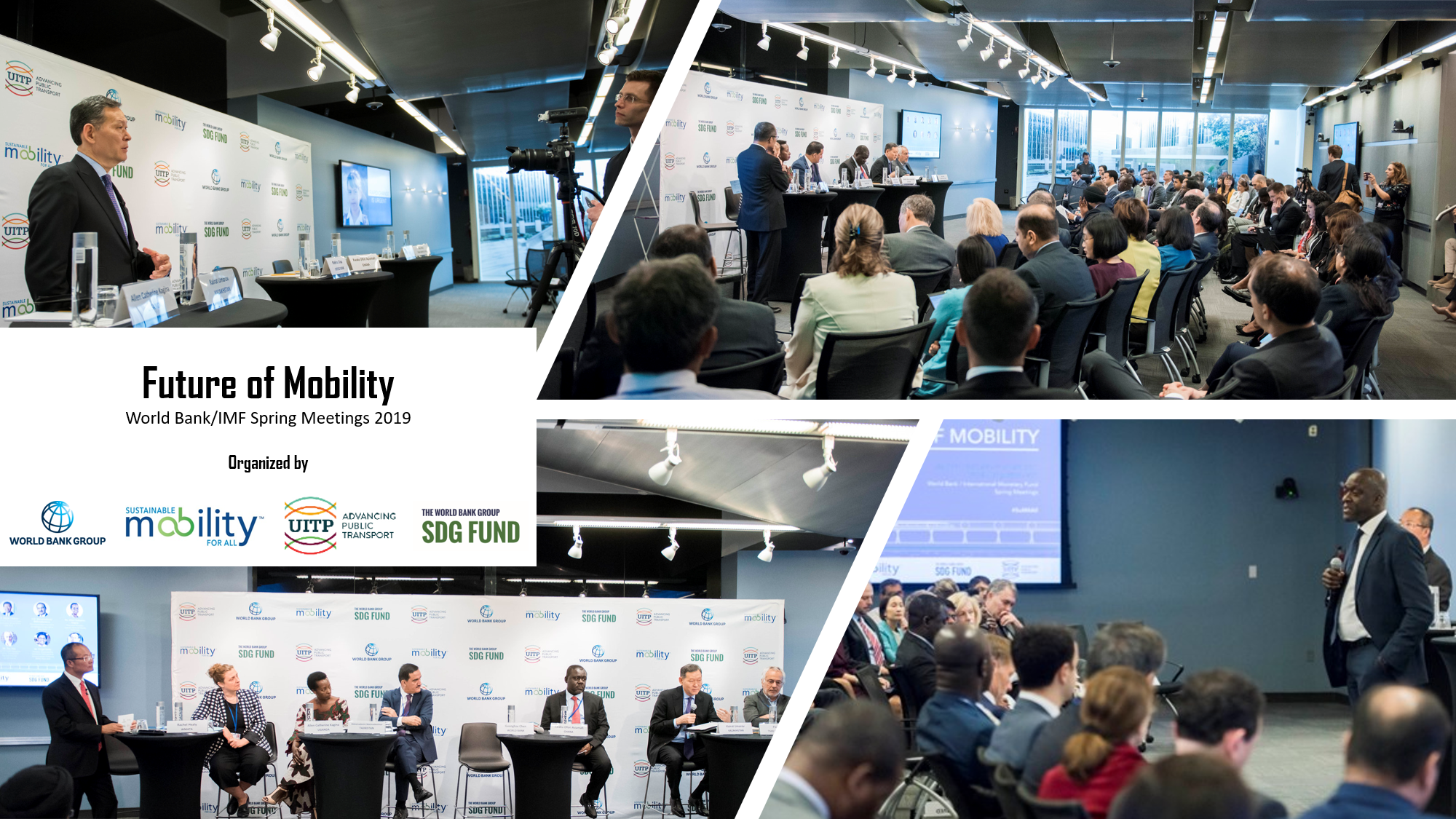
Economic growth, social inclusion, public health, environmental protection… mobility is at the core of many critical issues that have been shaping the global development agenda. This message came across loud and clear at the recent World Bank-IMF Spring Meetings, where the Sustainable Mobility for All initiative (SuM4All) organized a high-level event to identify concrete solutions for transforming mobility.
The conversation brought together a diverse group of leaders and policymakers that included: H.E. Kwaku Ofori Asiamah, Transport Minister of Ghana; H.E. Kairat Umarov, Permanent Representative of Kazakhstan to the UN in New York; H.E. Mahamadamin Mahmadaminov, Permanent Representative of Tajikistan to the UN in New York; Mr. Makhtar Diop, Vice President for Infrastructure at the World Bank; Mr. Vazil Hudák, Vice President of the European Investment Bank; Mr. Guangzhe Chen, Senior Director of the World Bank’s Transport Global Practice; Ms. Allen Catherine Kagina, Executive Director of the Uganda National Roads Authority; Ms. Rachel Healy, Director of the Office of Sustainability at the Washington Metropolitan Area Transit Authority (WMATA); and Mr. Pau Noy, Deputy Chief Executive Officer of Transports Metropolitans de Barcelona (TMB).
While participants touched upon a broad range of topics, four key areas stood out.
1. Sustainable mobility is a prerequisite to achieving the Sustainable Development Goals
All speakers highlighted that, without realizing sustainable mobility, the Sustainable Development Goals (SDGs) could not be achieved. If we are serious about meeting the 2030 SDGs deadline, then we must accelerate the implementation of policies that lead to sustainable mobility. Mr. Pau Noy commented, “sustainable mobility requires a policy shift from vehicles to people-centered mobility.” Mobility plans should account for the increased numbers of vehicles on the road and their impact on public health. Delivering on this agenda requires “coordination among agencies” and “partners coming together,” noted Ms. Healy.
2. The aspirations of landlocked developing countries need not be held hostage by geography
Landlocked countries face an even greater challenge when it comes to mobility. Their lack of access to the sea translates into higher export costs, making them less competitive in international markets. The average trade volume of a landlocked developing country is only 60% of what it would be in a comparable coastal country.
H.E. Kairat Umarov described how Kazakhstan, the largest landlocked developing country in the world, had managed to overcome these challenges. “A critical part of this effort has been to invest in […] missing international transport links to better connect the country with international markets,” stated H.E. Umarov. “For example, the launch of the Western Europe – Western China Automobile Transit Corridor better connects Kazakhstan with both European and Chinese markets by opening up a previously untapped trade route. To transport goods by sea from China to Europe takes 45 to 60 days. However, with the opening of this corridor across Kazakhstan, that journey is cut down to seven to 15 days. Kazakhstan has spent up to date $30 billion on transport infrastructure, which includes investments in 11 transit corridors that cut across the country.”
3. The role of technology in achieving sustainable mobility
Electric cars, autonomous vehicles, ridesharing apps, and other new technologies are revolutionizing the transport sector. However, many of these innovations tend to reinforce the current car-centric model, which could exacerbate problems like congestion and greenhouse gas emissions. To avoid this scenario, World Bank Vice President for Infrastructure Makhtar Diop stressed that the philosophy behind new technologies should be to promote public transport ridership.
Meanwhile, Ms. Allen Catherine Kagina highlighted that developing countries will have to overcome many obstacles before they can fully leverage these disruptive technologies, especially when it comes to providing enabling infrastructure. If you do not have a reliable supply of electricity, for instance, most technologies remain out of reach.
4. How do we pay for sustainable mobility?
The transition toward sustainable mobility can be expensive. Mr. Vazil Hudák pointed out that to achieve the SDGs by the 2030 deadline, the world must invest $3 to 5 trillion annually. The public sector or multilateral development banks alone are unable to mobilize this scale of financing, so we must tap into the $130 trillion of private sector assets which are not currently being utilized. Mr. Hudák shared how the European Union is trying to do exactly that by leveraging blended financing structures, which use public money from the EU budget as a way to encourage the private sector to be involved.
But there are also mobility projects that can make a significant impact with relatively little investment. The Ghanaian Minister of Transport, for instance, mentioned plans to develop an inland water transport system on Lake Volta—the largest man-made lake in the world—to better connect the north and south of his country.
As SuM4All continues to advance the sustainable mobility agenda worldwide, these insights will make an invaluable contribution to our work. And of course, you too can be a part of the conversation! If you have ideas and opinions about how we can build a brighter future for mobility, please share them in the section below, and find out how you can help inform our Global Roadmap of Action.


Join the Conversation